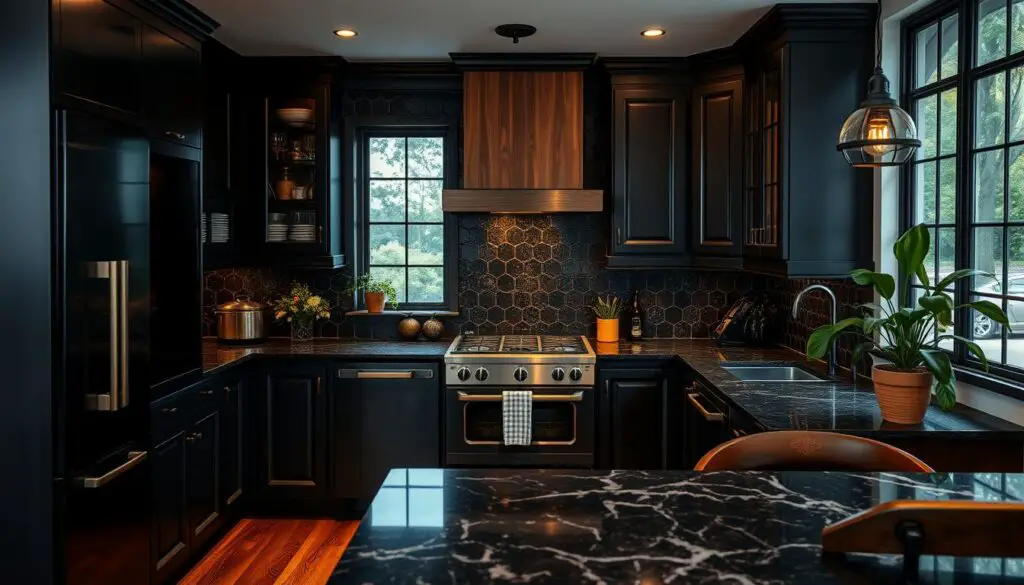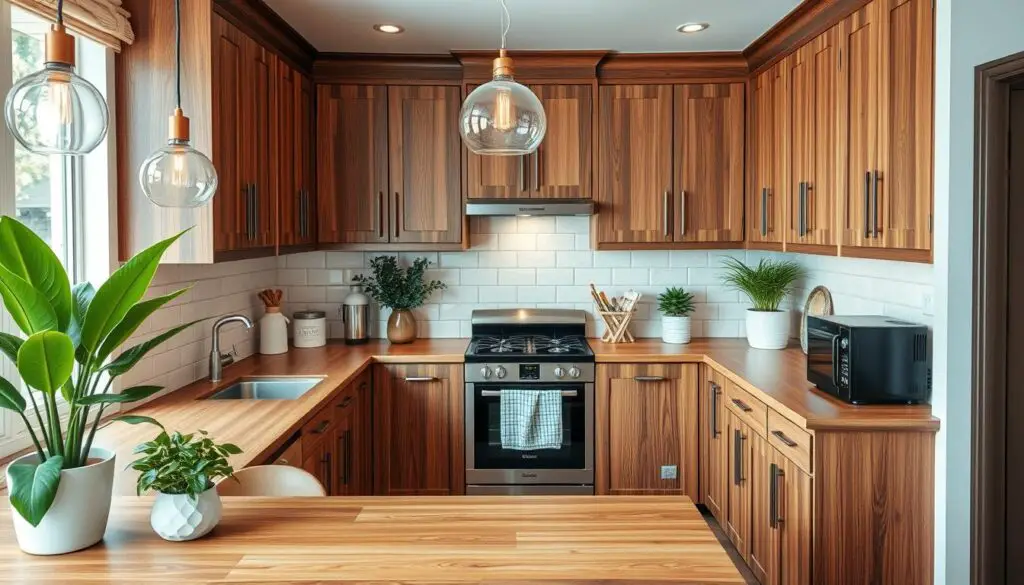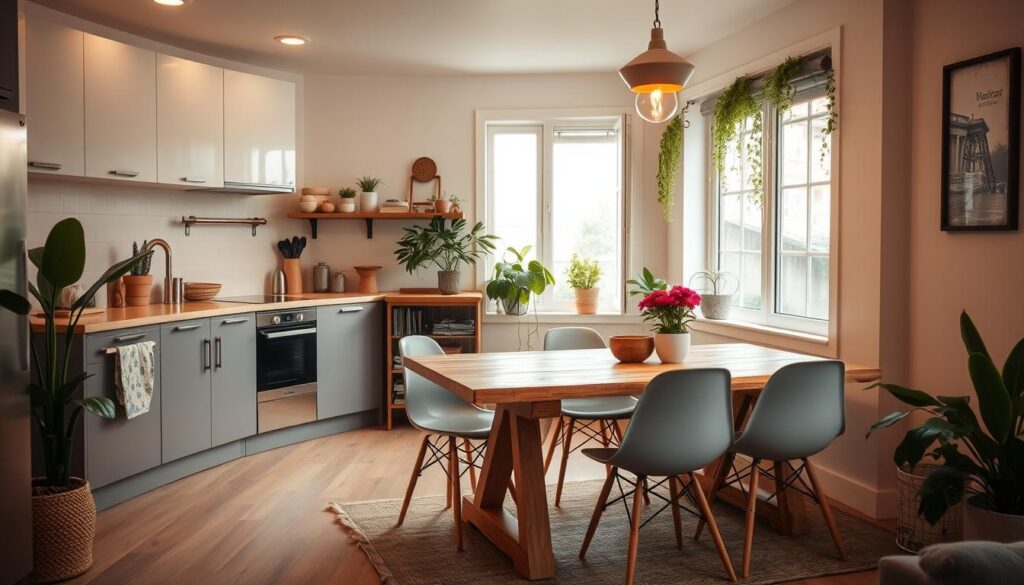
Creating a functional and inviting space in a small kitchen and dining area can be a challenge. But, with the right design strategies, you can make the most of your space. You can turn it into a beautiful area for cooking and dining.
Optimizing a compact kitchen and dining room requires careful planning. You need to think about the layout, lighting, and furniture. This will help you create a harmonious and functional space. In this article, we will explore various design ideas to help you make the most of your small kitchen and dining area.
We will give you inspiration for clever storage solutions and stylish furniture. This will help you create a space that is both functional and aesthetically pleasing. Let’s dive into the world of compact kitchen and dining room design. Discover how to make your space shine.
Maximize Storage with Vertical Solutions
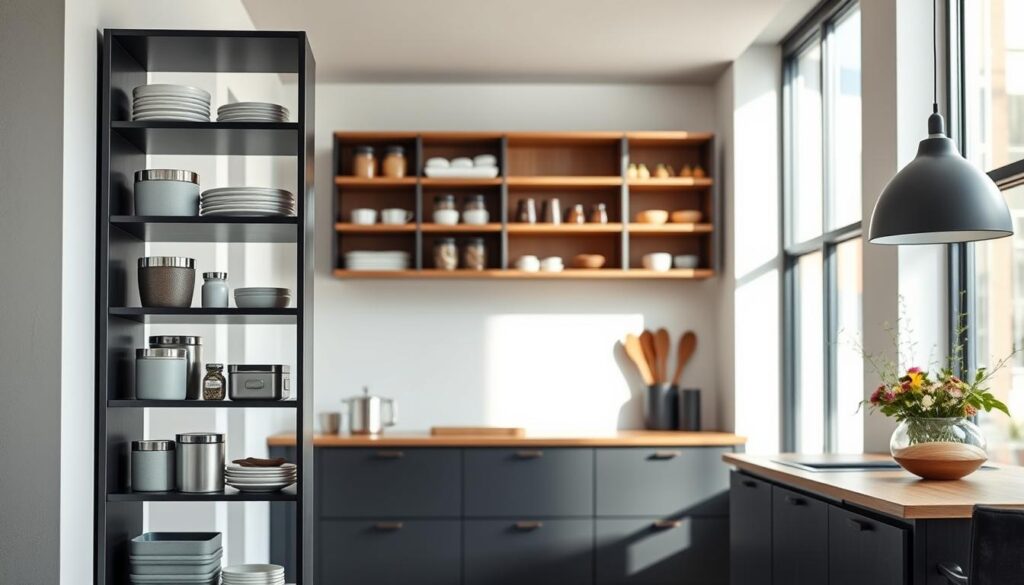
In small kitchens and dining rooms, using vertical space can really help with storage. By focusing on vertical solutions, you can clear your floors and countertops. This makes your space feel bigger and more organized.
Tall cabinets are a great way to use vertical space. They can hold items like special occasion dishes, cookbooks, or seasonal decorations. Tall cabinets are especially useful in small kitchens where every inch matters.
Tall Cabinets
Tall cabinets are a smart choice for small kitchens. They offer lots of storage without taking up too much floor space. You can store kitchen gadgets, food supplies, and more. When picking tall cabinets, think about the material, size, and style to match your kitchen.
Wall-Mounted Shelves
Wall-mounted shelves are another great option for vertical space. They’re perfect for storing cookbooks, decorative items, or kitchen utensils. Floating shelves can also add a modern look to your kitchen while providing extra storage.
Pegboards for Easy Access
Pegboards are a versatile and efficient storage solution for small kitchens. By installing a pegboard on a wall or the back of a cabinet door, you can hang utensils, pots, and pans. This is especially helpful when counter space is limited.
| Storage Solution | Benefits | Ideal Use |
|---|---|---|
| Tall Cabinets | Ample storage, keeps items out of the way | Storing less frequently used items |
| Wall-Mounted Shelves | EASY access, adds a modern touch | Storing cookbooks, decorative items, kitchen utensils |
| Pegboards | Versatile, efficient, keeps utensils organized | Hanging utensils, pots, and pans |
Create an Open Concept Feel
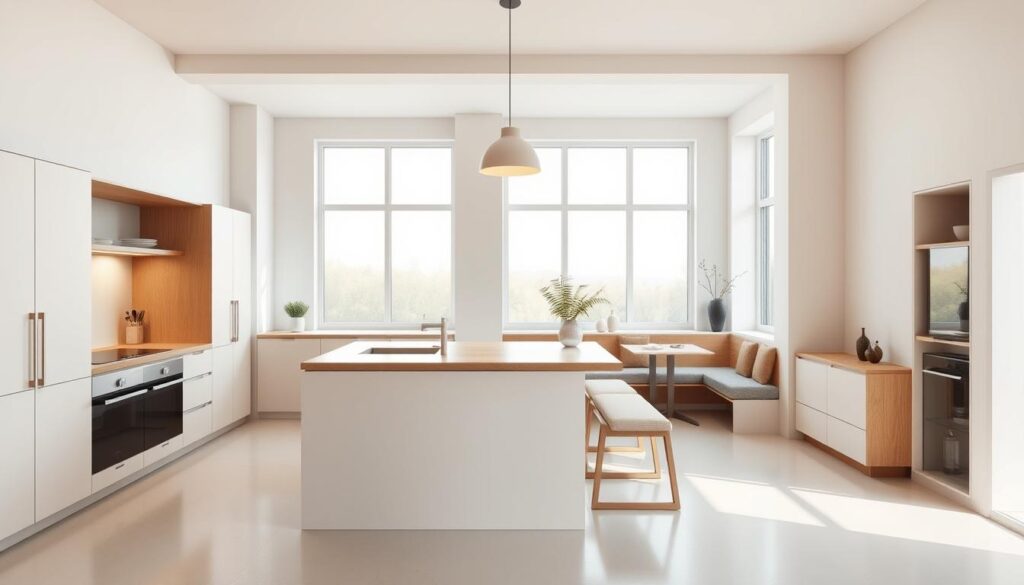
To make your compact kitchens and dining areas feel open, use a few key design elements. An open concept can make your space feel larger and more welcoming.
Use a Color Palette
Choosing a cohesive color palette is key for an open concept. Light and neutral colors make rooms feel bigger. “A consistent color scheme can visually expand a small space,” says design expert, Emily Henderson.
Use soft whites, creams, and grays to keep the look continuous.
“Color is a powerful tool in interior design. It can greatly impact the perceived size of a room.”
Remove Unnecessary Walls
Removing walls can greatly enhance an open concept feel. By removing barriers, you create a more fluid space. This is especially useful in small kitchens and dining areas.
Utilize Clear Furniture
Clear or transparent furniture also helps create an open concept. Clear furniture, like acrylic chairs or glass tables, makes rooms feel less cluttered. This is great for small spaces where big items can make it feel cramped.
- Choose transparent or clear furniture pieces.
- Opt for minimalist designs to maintain the sense of openness.
- Consider the scale of the furniture in relation to the room size.
By using these strategies, you can make your small kitchen and dining area feel more open and inviting. The goal is to keep the space flowing and continuous.
Utilize Every Corner Efficiently
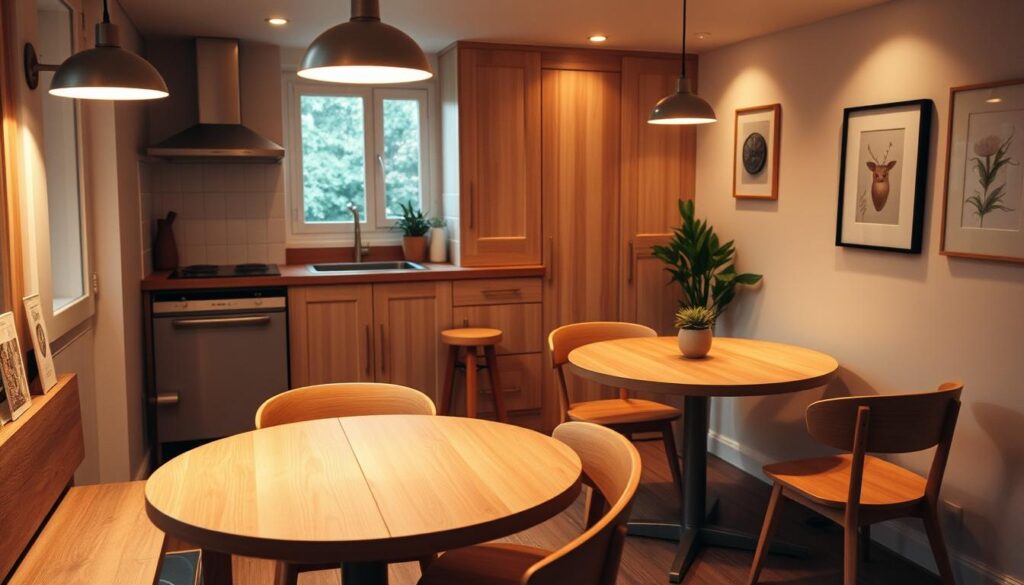
In small kitchens and dining rooms, every corner is crucial. It’s key to use every corner well to save space.
Corner Shelves
Corner shelves are great for adding storage without using too much floor space. They’re perfect for holding cookbooks, kitchen tools, or decorations. This keeps things tidy and within reach.
Benefits of Corner Shelves:
- Maximizes vertical space
- Keeps frequently used items accessible
- Adds a decorative element to the room
L-Shaped Furniture Arrangement
An L-shaped furniture setup is smart for small spaces. It helps define areas like the kitchen and dining room. This layout works well in open-plan areas, creating a clear separation.
Considerations for L-Shaped Layouts:
| Layout Aspect | Benefit |
|---|---|
| Space Efficiency | Makes the most of corner spaces |
| Functional Division | Separates kitchen and dining areas effectively |
| Flow | Enhances the workflow in the kitchen |
Round Dining Tables
Round dining tables are smart for small spaces. They offer several benefits over square tables. They improve flow and create a cozy dining feel.
Advantages of Round Dining Tables:
- Promotes social interaction
- Fits well in compact spaces
- Creates a cozy atmosphere
Invest in Space-Saving Furniture
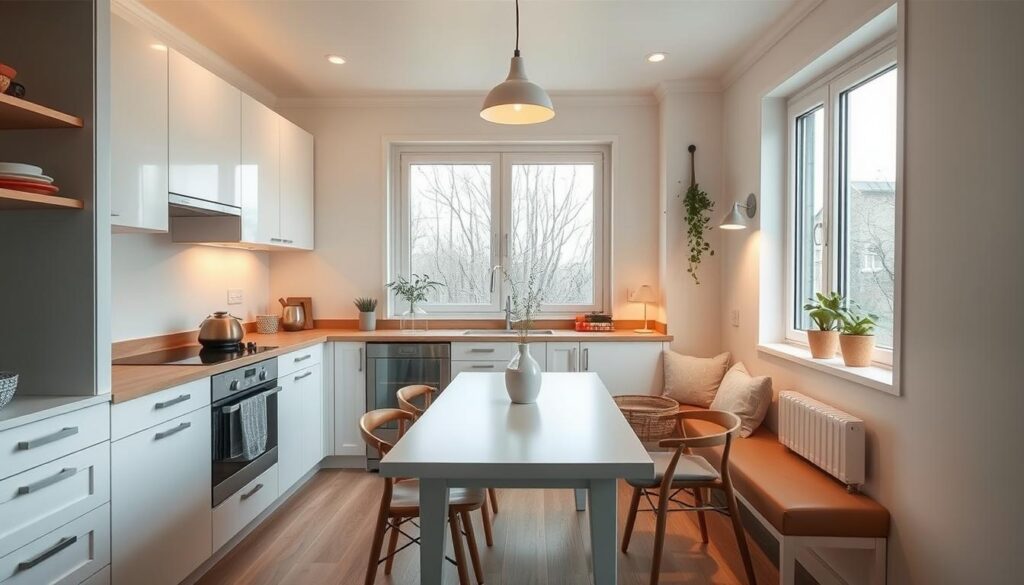
Homeowners with small kitchens and dining areas can greatly benefit from space-saving furniture. This type of furniture is both functional and compact. It helps create a more open and welcoming space in your home.
Foldable Dining Tables
Foldable dining tables are a smart choice for saving space. They can be folded and stored away when not in use. This frees up valuable floor space. Look for tables with a simple folding mechanism for easy setup and takedown.
Stackable Chairs
Stackable chairs are another excellent option for small kitchens and dining areas. They can be stacked on top of each other when not in use. This reduces clutter and makes cleaning the floor easier. Choose chairs that are both stylish and durable for regular use.
Multi-Functional Kitchen Islands
A multi-functional kitchen island offers extra counter space, storage, and even seating. Look for islands with built-in cabinets, drawers, or shelves for better organization. Some islands have foldable or retractable countertops, adding to their space-saving benefits.
By adding these space-saving furniture pieces to your small kitchen remodel, you can make your space more functional and beautiful. It will meet your needs and inspire your cooking creativity.
Enhance Lighting to Open Up Space
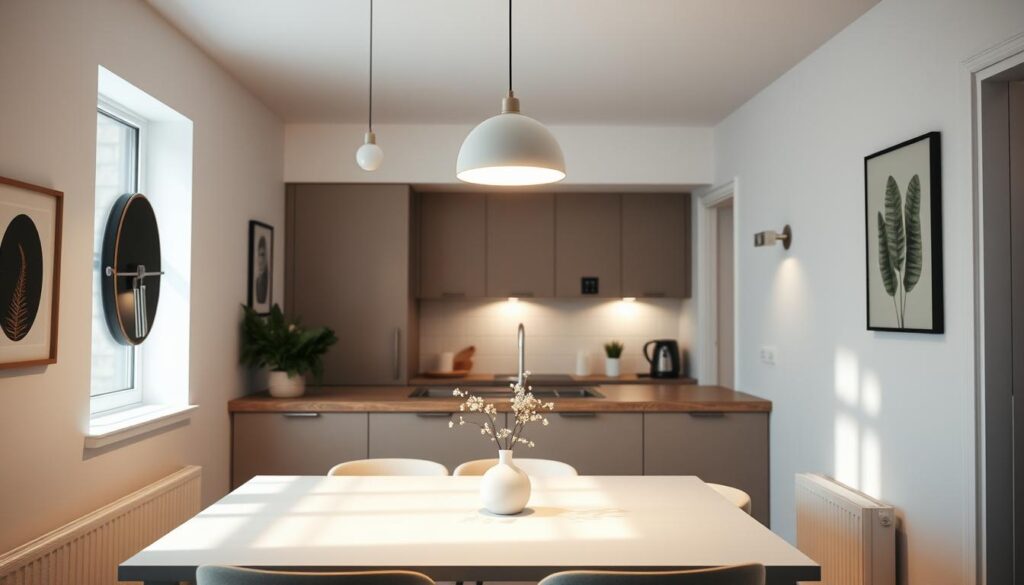
Good lighting is key to making small kitchens and dining areas feel bigger and more inviting. The right lighting can make these spaces look larger and more welcoming.
Installing pendant lights over the dining table is a smart move. Pendant lights offer focused light and add style to the room. They come in many styles, fitting any kitchen or dining area’s look.
Pendant Lights Over the Table
Pendant lights are great for small spaces because they make the room feel taller. When picking pendant lights, think about their size compared to the table and room.
Under-Cabinet Lighting
Under-cabinet lighting is also a smart choice for small kitchens. It lights up countertops and reduces shadows, making the kitchen look bigger and easier to move around. LED strip lights are a top pick for this because they save energy and are flexible.
Natural Light Through Windows
Getting as much natural light as possible is vital for a bright, airy feel. Make sure windows are clear and use sheer curtains or blinds to let in more light. Mirrors placed opposite windows can also bounce natural light around, making the space feel even bigger.
Using these lighting tips can greatly improve the look and feel of small kitchens and dining areas. It makes these spaces more functional and enjoyable.
Choose the Right Color Scheme
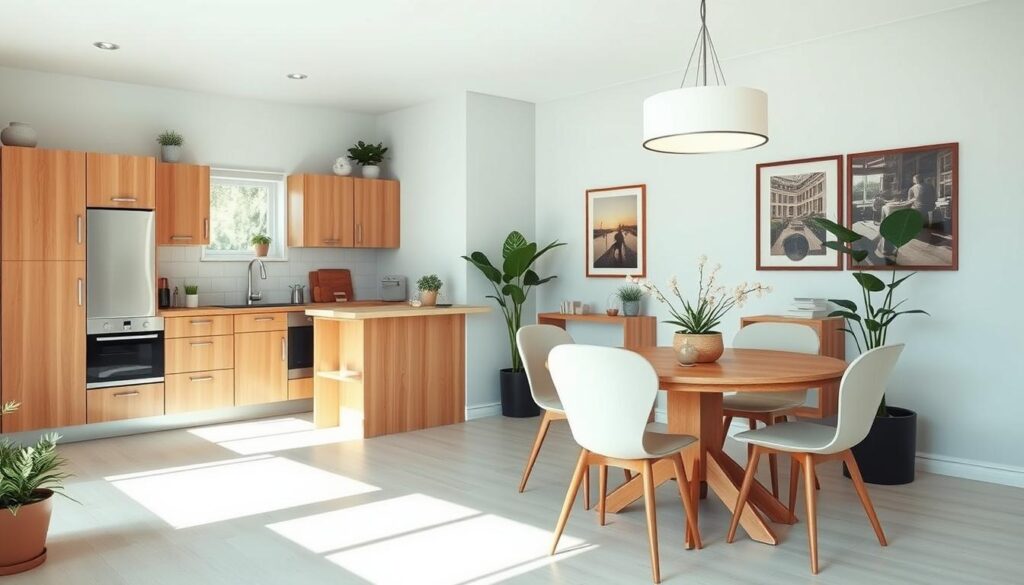
A good color scheme can make small kitchens and dining areas feel bigger. The right colors can trick the eye into seeing more space. They also improve the room’s feel.
Light and Airy Neutrals
Light and airy neutrals are popular for small spaces. Shades like white, beige, and soft grays make rooms feel larger and more open.
Benefits of Neutral Colors:
- Creates a sense of spaciousness
- Enhances natural light
- Provides a clean and fresh look
Bold Accents for Small Spaces
Neutrals are great for the main color, but bold accents add personality. Use vibrant colors in accessories or a statement wall for interest.
Tips for Using Bold Accents:
- Use bold colors sparingly to avoid overwhelming the space
- Choose accents that complement the main color scheme
- Consider the 60-30-10 rule: 60% main color, 30% secondary color, and 10% accent color
Monochromatic Looks
A monochromatic scheme uses different shades of one color. It creates a cohesive look in small spaces.
Focus on Strategic Placement
Decorative mirrors can make spaces seem bigger. Place mirrors to reflect light and images, enhancing the area’s size.
Strategic Placement Tips:
| Placement | Effect |
|---|---|
| Opposite a window | Reflects natural light, making the space feel brighter and larger |
| On a wall adjacent to the dining area | Creates the illusion of a larger dining space |
| Behind a light source | Amplifies the light, making the area feel more spacious |
Use Different Shapes
Mirrors of different shapes add interest and uniqueness. Round, square, or rectangular mirrors complement the decor.
Layer Textures for Depth
Layering textures adds depth to small spaces. Mix smooth with rough, or metallic with matte for a visually appealing space.
Examples of Texture Layering:
- Pairing a smooth countertop with a textured backsplash
- Combining metallic lighting fixtures with a matte finish table
- Using a mix of glossy and matte finishes on cabinets and furniture
Incorporate Smart Technology
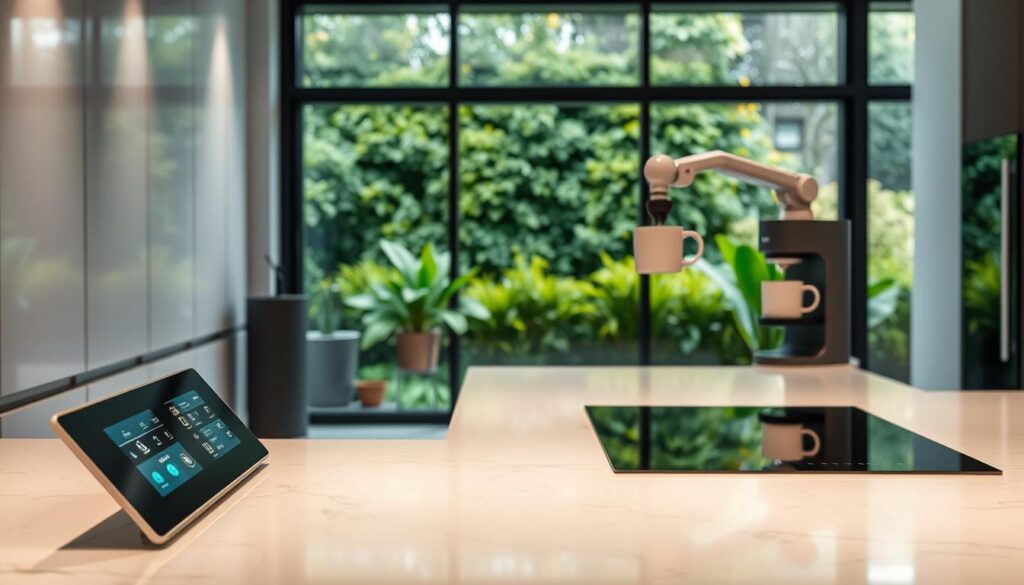
Homeowners can change their small kitchens and dining areas with smart technology. This makes the space more functional and efficient. It helps make the most of the available space.
Using advanced appliances is a key way to add smart technology. Smart Appliances are not just efficient; they’re also very convenient. For example, smart refrigerators can track what’s inside, and smart ovens can be preheated from afar.
Revolutionizing Kitchen Tasks
Smart appliances are changing how we use our kitchens. A report by Consumer Reports says, “smart appliances are getting popular. They offer benefits like energy savings and better cooking experiences.”
- Smart Refrigerators with internal cameras to check contents remotely
- Smart Ovens that can be controlled via smartphone apps
- Dishwashers that can be programmed and monitored remotely
Automated Lighting is another big part of smart kitchens. It lets homeowners adjust lighting levels as needed. This improves both the look and function of the space. Automated lighting can turn on or off at set times or when it senses movement.
“The future of kitchen design lies in smart technology, where every element, from lighting to appliances, is interconnected and optimized for efficiency.” –
Smart Lighting Solutions
| Feature | Benefit | Example |
|---|---|---|
| Motion Detection | Automatically turns on/off lights | Philips Hue |
| Programmable Timers | Adjusts lighting according to schedule | Lutron Caséta |
| Dimmable Lights | Enhances ambiance and saves energy | Belkin Wemo |
Voice-Controlled Assistants are key in smart kitchens. Devices like Amazon Alexa and Google Assistant let homeowners control appliances, play music, and set reminders with voice commands.
Adding smart technology to small kitchens and dining areas improves the space and living experience. With smart appliances, automated lighting, and voice-controlled assistants, homeowners can enjoy a more efficient and futuristic kitchen.
Bring in Natural Elements
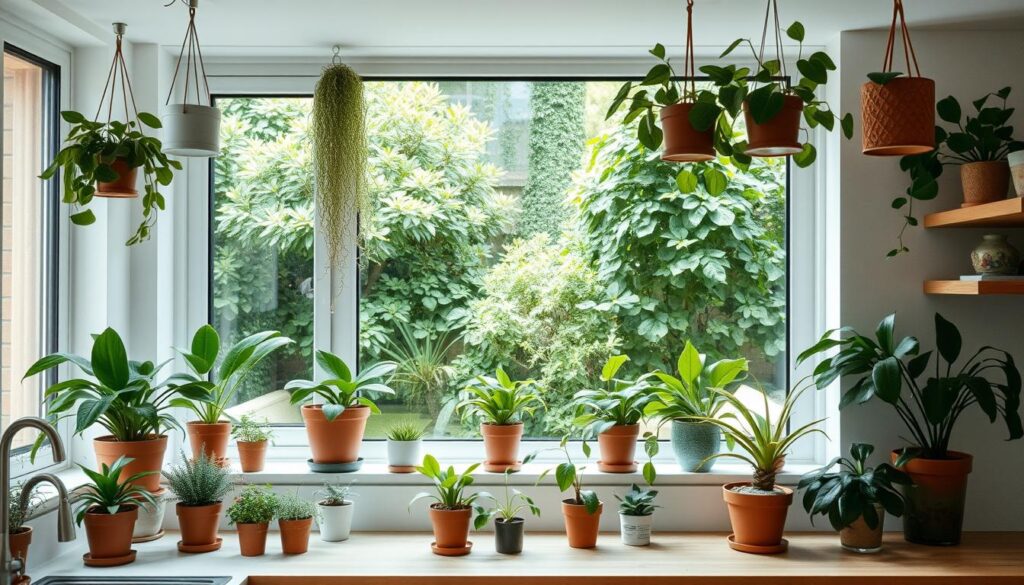
Adding natural elements to your kitchen can make a big difference. It can turn a small kitchen into a cozy and inviting space.
One easy way to do this is with indoor plants. They clean the air and add greenery. Pick plants like succulents or herbs that are easy to care for.
Indoor Plants
Indoor plants make your kitchen feel calm. Some great choices include:
- Pothos
- Snake Plant
- Peace Lily
Wooden Accents
Adding wooden accents brings warmth and texture. Think about wooden floors, cabinets, or a dining table for a unified look.
Stone Countertops
Stone countertops are a smart choice for natural elements. Options like granite, marble, or quartz are stylish, durable, and simple to keep clean.
| Natural Element | Benefits | Examples |
|---|---|---|
| Indoor Plants | Air purification, aesthetic appeal | Pothos, Snake Plant |
| Wooden Accents | Warmth, texture | Wooden flooring, cabinets |
| Stone Countertops | Durability, luxurious feel | Granite, Marble, Quartz |
With these natural elements, your small kitchen and dining area will feel bigger and more welcoming. It will also feel connected to nature.
Personalize with Artwork and Decor
Make your small kitchen and dining area special by adding artwork and decor. This personal touch makes the space feel welcoming and adds character.
Gallery Walls
Gallery walls are a great way to add interest to your space. Mix frames of different sizes and styles to create a unique focal point. It will catch the eye and start conversations.
Seasonal Touches
Adding seasonal decorations is a smart way to personalize your area. For inspiration, think about adding decor that matches your style, like holiday items or summer colors.
Functional Decor
Functional decor can also improve your dining area’s look. Items like decorative baskets or stylish utensil holders are both useful and stylish. They add to the space’s overall look.

